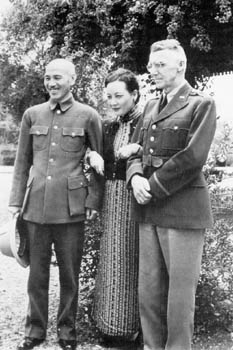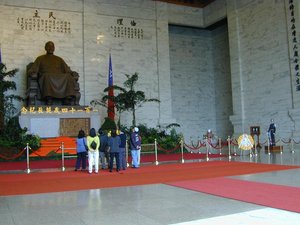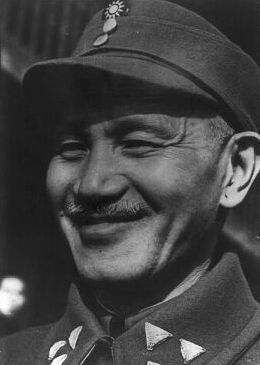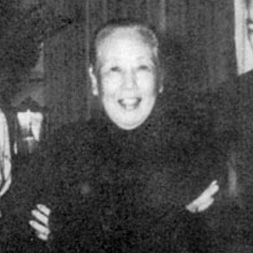Chiang Kai-shek
|
|
| Names (details) | |
|---|---|
| Known in English as: | Chiang Kai-shek |
| Known in mainland China as: | 蔣介石 |
| Hanyu Pinyin: | Jiǎng Jièshí |
| Wade-Giles: | Chiang Chieh-shih |
| Known in Taiwan as : | 蔣中正 |
| Hanyu Pinyin: | Jiǎng Zhōngzhèng |
| Wade-Giles: | Chiang Chung-cheng |
| Family name: | Jiang |
| Traditional Chinese: | 蔣 |
| Simplified Chinese: | 蔣 |
| Given | names |
| Register name (譜名): | Zhoutai (周泰) |
| Milk name (乳名): | Ruiyuan (瑞元) |
| School name (學名): | Zhiqing (志清), |
| later Zhongzheng (中正) | |
| Courtesy name (字): | Jieshi (介石), pronounced |
| Kai-shek in Cantonese | |
Chiang Kai-shek (October 31, 1887–April 5, 1975) was a Chinese military and political leader who assumed the leadership of the Kuomintang (KMT) after the death of Sun Yat-sen in 1925. He commanded the Northern Expedition to unify China against the warlords and emerged victorious in 1928 as the overall leader of the Republic of China (ROC). Chiang led China in the Second Sino-Japanese War, during which Chiang's stature within China weakened but his international prominence grew. During the Chinese Civil War (1926–1949), Chiang attempted to eradicate the Chinese Communists but ultimately failed, forcing his government to retreat to Taiwan, where he established the Republic of China and was its president for the remainder of his life.
| Contents |
Early life
Chiang was born in the town of Xikou, in Fenghua County, Ningbo Prefecture, Zhejiang Province. Xikou is approximately 33 km (20.5 miles) southwest of Ningbo.
His parents were Chiang Zhaocong (蔣肇聰) and Wang Caiyu (王采玉), part of a upper-middle class family of salt merchants. In an arranged marriage, Kai-shek was married to fellow villager Mao Fumei1 (毛福梅, 1882–1939). Chiang and Mao had a son, Ching-Kuo, and a daughter, Chien-hua (建華).
Chiang grew up in an era where military defeats had left China destabilized and in debt, and he decided to join the military. He began his military education at the Paoting Military Academy in 1906. He left for the Military State Academy in Japan in 1907. There, he was influenced by his compatriots to support the revolutionary movement to overthrow the Qing Dynasty and set up a Chinese republic. In 1908, Chiang joined the Tong-meng Hui. He served in the Imperial Japanese Army from 1909 to 1911.
Rise to power
With the outbreak of the Wuchang Uprising in 1911, Chiang returned to China to fight in the revolution. He served in the revolutionary forces, leading a regiment in Shanghai under his friend and mentor Chen Qimei. The revolution was ultimately successful and Chiang became a founding member of the Kuomintang.
After the takeover of the Republican government by Yuan Shikai, Chiang became Sun Yat-sen's protégé and divided his time between exile in Japan and haven in Shanghai's foreign concession areas. In Shanghai, Chiang also cultivated ties with the criminal underworld dominated by the notorious Green Gang and later served as an officer in the army of the Cantonese Warlord, Ch'en Chiung-ming. In 1923 Sun Yat-sen moved his base of operations to Guangzhou, and, with the help of the Comintern, undertook a reform of the Kuomintang and established a revolutionary government. That same year, Sun sent Chiang Kai-shek to spend three months in Moscow studying the Soviet political and military system. Chiang returned to Guangzhou and in 1924 was made Commandant of the Whampoa Military Academy. The early years at Whampoa allowed Chiang to cultivate a cadre of young officers loyal to him and by 1925 Chiang's proto-army was scoring victories against local rivals in Guangdong province.
With Sun Yat-sen's death in 1925 a power vacuum developed in the KMT. Though Chiang ranked relatively low in the civilian hierarchy his deft political maneuvering allowed him to emerge victorious. Chiang became Commander-in-Chief of the National Revolutionary Forces in 1925, and in July 1926, launched the successful Northern Expedition, a military campaign to defeat the warlords controlling northern China and unify the country under the KMT.
In January 1927, allied with the Chinese Communists and Soviet Agent Mikhail Borodin, KMT leftists moved the civilian government from Guangzhou to Wuhan in central China. After conquering Shanghai and Nanjing in March, Chiang decided to break with the leftists. On April 12, Chiang began a swift and brutal attack on thousands of suspected Communists in the area he controlled. He then established his own KMT government in Nanjing, supported by his conservative allies. The communists and other leftists were purged from the KMT and the Soviet advisers were expelled. The warlord capital of Beijing was taken in June 1928.
On December 1, 1927, Chiang married Soong May-ling, the younger sister of Soong Ching-ling (Sun Yat-sen's widow, whom he had proposed to beforehand but was swiftly rejected) in Japan. To please Soong's parents, Chiang had to first divorce his first wife and concubines and promise to eventually convert to Christianity. He was baptised in 1929.
Tutelage over China
Chiang Kai-Shek gained nominal control of China, but his party was "too weak to lead and too strong to overthrow". In 1928, Chiang was named Generalissimo of all Chinese forces and Chairman of the National Government, a post he held until 1932 and later from 1943 until 1948.

The decade of 1928 to 1937 was one of consolidation and accomplishment for Chiang's government. Some of the harsh aspects of foreign concessions and privileges in China were moderated through diplomacy. The government acted energetically to modernize the legal and penal systems, stabilize prices, amortize debts, reform the banking and currency systems, build railroads and highways, improve public health facilities, legislate against traffic in narcotics, and augment industrial and agricultural production. Great strides also were made in education and, in an effort to help unify Chinese society--the New Life Movement was launched to stress Confucian moral values and Mandarin was promoted as a standard tongue. The widespread establishment of communications facilities further encouraged a sense of unity and pride among the people. These successes, however, were met with constant upheavals with need of further political and military consolidation. Chiang fought with most of his warlord allies, with one northern rebellion in 1930 almost bankrupting the government and costing almost 250,000 casualties. A break with Hu Han-min in 1931 almost toppled his government.
A complete eradication of the Communist Party of China eluded Chiang. The Communists regrouped in Jiangxi and established the Chinese Soviet Republic. Chiang's anti-communist stance attracted the aid of German military advisers, and in Chiang's fifth campaign to defeat the Communists in 1934, he surrounded the Red Army only to see the Communists escape through the epic Long March to Yan'an.
Wartime leader of China
With Japan's invasion of Manchuria in 1931, Chiang adopted a slogan "first internal pacification, then external resistance" which meant that the government should first defeat the Communists before challenging Japan directly. This was widely unpopular and in 1936, one of Chiang's allied commanders, Zhang Xueliang instigated the Xi'an Incident. Chiang was kidnapped and forced into making an "united front" with the Communists against Japan. Chiang later denied making any agreement and continued fighting the Communists throughout the war.
All-out war broke out in 1937. In August of the same year, Chiang sent 500,000 of his best trained and equipped soldiers to defend Shanghai. With about 250,000 Chinese casualties, Chiang lost his political base of Whampoa-trained officers. He subsequently moved the government inland to Chongqing. Devoid of economic and industrial resources, Chiang could not counter-attack and held off the rest of the war preserving whatever territory he still controlled.
With the Attack on Pearl Harbor and the opening of the Pacific War, China became one of the Allied Powers. During and after World War II, Chiang and his American-educated wife Soong May-ling, commonly referred to as "Madame Chiang Kai-shek", held the unwavering support of the United States China Lobby which saw in them the hope of a Christian and democratic China. Chiang Kai-shek's policies were far from Christian or democratic, but this remained unknown to the U.S. public due to strong state-imposed censorship in China and self-imposed censorship in the U.S. during the war years and after.

Chiang's strategy during the War opposed the strategies of both Mao Zedong and the United States. The U.S. regarded Chiang as an important ally able to help shorten the war by engaging the Japanese occupiers in China. Chiang, in contrast, used powerful associates such as H. H. Kung in Hong Kong to build the ROC army for certain conflict with the communist forces after the end of WWII. This fact was not understood well in the U.S. The U.S. liaison officer, General Joseph Stilwell, correctly apprehended Chiang's strategy was to accumulate munitions for future civil war rather than fight the Japanese, but Stilwell was unable to convince Franklin D. Roosevelt of this and precious Lend-Lease armaments continued to be allocated to the Kuomintang. Chiang was recognized as one of the "Big Four" Allied leaders along with Roosevelt, Churchill, and Stalin and travelled to attend the Cairo Conference in November 1943. His wife acted as his translator and adviser.
The U.S. suspended aid to Chiang Kai-shek for much of the period 1946-48, in the midst of civil war against the People's Liberation Army led by Mao Zedong. Though Chiang achieved great status internationally, his government was deteriorating with corruption and inflation. The war had severely weakened the Nationalists both in terms of resources and popularity while the Communists were strengthened by a guerrilla organization extending throughout rural areas.
Under a new Constitution passed in 1947, Chiang was elected by the National Assembly to be President.
Chiang resigned as President (and Vice President Li Tsung-jen became Acting President) on January 21, 1949, as KMT forces suffered massive losses against the communists in the Chinese Civil War. In the early morning of December 10, 1949, CPC troops laid siege to Chengdu, the last KMT occupied city in mainland China, where Chiang Kai-shek and his son Chiang Ching-kuo directed the defense at the Chengdu Central Military Academy. The aircraft May-ling evacuated them to Taiwan on the same day; they would never return to mainland China.
Presidency in Taiwan
Chiang moved his government to Taipei, Taiwan, where he resumed his duties as president on March 1, 1950. Chiang was reelected by the National Assembly (or rather the KMT) to be the President of the ROC on May 20, 1954 and later on in 1960, 1966, and 1972. In this position he continued to claim sovereignty over all of China. In the context of the Cold War, most of the Western world recognized this position and the ROC represented China in the United Nations and other international organizations.
Despite the democratic constitution, the government under Chiang was a repressive and authoritarian single-party state; the "Temporary Provisions Effective During the Period of Communist Rebellion" greatly enhanced executive power and the goal of "retaking the mainland" allowed the KMT to maintain its monopoly on power and to outlaw opposition parties.
Defeated by the Communists, Chiang purged members of the KMT previously accused of corruption, and major figures in the previous mainland government such as H.H. Kung and T.V. Soong exiled themselves to the United States. Generous American foreign aid and sound Japanese infrastracture laid the foundation for Taiwan's economic success, becoming one of the East Asian Tigers. During this time Chiang received an honorary degree from Bob Jones University.
Death and legacy
Tzuhu.jpg

In 1975, 26 years after Chiang fled to Taiwan, he died in Taipei at the age of 88. He had suffered a major heart attack and pneumonia in the months before and died from renal failure aggravated with advanced cardial malfunction at 11 p.m. on April 5.
A month of mourning was declared during which the Taiwanese people were asked to put on black armbands. Televisions ran in black-and-white while all banquets or celebrations were forbidden. On the mainland, however, Chiang's death was met with the brief headline "Chiang Kai-shek has died." Chiang's corpse was put in a copper coffin and temporarily interred at his favorite residence in Cihhu, Dasi, Taoyuan County. When his son Chiang Ching-kuo died in 1988, he was also entombed in a separate mausoleum in nearby Touliao. The hope was to have both buried at their birthplace in Fenghua once the mainland was recovered. In 2004, Chiang Fang-liang, the widow of Chiang Ching-kuo, asked that both father and son be buried at Wuchih Mountain Military Cemetery in Sijhih, Taipei County. The state funeral ceremony is planned for late 2005. Chiang Fang-liang and Soong May-ling had agreed in 1997 that the former leaders be first buried but still be moved to mainland China in the event of reunification.
Chiang was succeeded as President by Vice President Yen Chia-kan. However, real power passed to his son Chiang Ching-kuo, who was premier and became President after Yen's term ended three years later.
Though one of the major figures in Chinese history, Chiang Kai-shek failed to cultivate in the Chinese people the affection of Sun Yat-sen or the regard of Mao Zedong. As Mao's number-one nemesis, he was vilified in mainland China as a leader who did not serve China's best national interest in not putting an all-out effort against Japan and in trying to crack down on the Communists. Although numbers are uncertain, many estimates place the number of deaths as a result of Chiang Kai-shek's rule on the mainland at around ten million (the lowest estimates provide a figure of about four million, while higher figures suggest as many as 18 million). Many deaths were the result of famine, but according to R.J. Rummel approximately four million were killed directly. Even the lower figures would suggest that Chiang Kai-shek has been responsible for more deaths than all but a handful of 20th-century dictators.
Chiang Kai-shek remains a largely unpopular figure on Taiwan because of his authoritarian rule of the island. Since the democratization of the 1990s, his picture has tended to disappear from public buildings, coins, and money; in sharp contrast to his son Ching-kuo and to Sun Yat-sen, his memory is rarely invoked by current political parties, including the Kuomintang.
Names
Like many other Chinese historical figures, Chiang Kai-shek used several names throughout his life, and he is known under several of these names.
The "real" name of Chiang Kai-shek (the concept of real or original name is not as clean-cut in China as it is in the Western world), the name inscribed in the genealogical records of his family, is Jiang Zhoutai (蔣周泰). This "register name" (譜名) is the name under which his extended relatives of the family knew him, this is a name that was used in formal occasions, such as when he got married. Traditionally, this name was not used in intercourse with people outside of the family, and inside mainland China or Taiwan few people know that his real name was Jiang Zhoutai (although other historical figures such as Mao Zedong are known by their "register name").
This name, however, was not the name that he received when he was born. Traditionally, Chinese families would wait a certain number of years before officially naming their offspring. In the meantime, they used so-called "milk names" (乳名) which were given to the infant shortly after his birth, and which were known only by the close family. Thus, the actual name that Chiang Kai-shek received at birth was Jiang Ruiyuan (蔣瑞元), but again this is a fact rarely known in mainland China or Taiwan, and only his parents would have used the given name Ruiyuan when calling him.
In 1903, 16-year-old Chiang Kai-shek went to Ningpo to be a student, and he chose a so-called "school name" (學名). The "school name" was actually the formal name of a person, the name used by older people to call the person, so it was the name that the person would use the most in the first decades of his life (as the person grew older, younger generations would have to use one of the courtesy names instead). Colloquially, the "school name" is called "big name" (大名), whereas the "milk name" is known as the "small name" (小名). The "school name" that Chiang Kai-shek chose for himself was Zhiqing (志清 - meaning "purity of intentions"). For the next fifteen years or so, Chiang Kai-shek was known as Jiang Zhiqing. This is the name under which Sun Yat-sen knew him when Chiang joined the republicans in Guangzhou in the 1910s.
In 1912, when Chiang Kai-shek was in Japan, he started to use the name Jiang Jieshi (蔣介石) as a pen name for the articles that he published in a Chinese magazine he founded (Voice of the Army - 軍聲). This name Jieshi soon became his courtesy name (字). Many interpretations of this name circulate. Some think the name was chosen from the classic Chinese book the Book of Changes, other note that jie (介), the first character of his courtesy name, is also the first character of the courtesy name of his brother and other male relatives on the same generation line, while the second character of his courtesy name shi (石 - meaning "stone") reminds of the second character of his "register name" tai (泰 - the famous Mount Tai of China). Courtesy names in China often tried to bear a connection with the personal name of the person. As the courtesy name is the name used by people of the same generation to call the person, Chiang Kai-shek soon became known under this new name, pronounced Jieshi in Mandarin, but pronounced Kai-shek in Cantonese. As the republicans were based in Guangzhou (in Cantonese speaking area), Chiang Kai-shek became known by Westerners under the Cantonese romanization of his courtesy name. In mainland China, this is still the name under which he is commonly known today, but pronounced in Mandarin: Jiang Jieshi.
In 1917 or 1918, as Chiang was coming to the forefront among the republicans and became close to Sun Yat-sen, he changed his name from Jiang Zhiqing to Jiang Zhongzheng (蔣中正). This was a clever choice. Sun Yat-sen was (and still is) known in China as Zhongshan (中山 - meaning "central mountain"). By adopting the name Zhongzheng ("central uprightness"), he was choosing a name very similar to the name of Sun Yat-sen, establishing a close link between the two. The meaning of uprightness, rectitude, or orthodoxy, implied by his name, also positioned him as the legitimate heir of Sun Yat-sen and his ideas. Not surprisingly, the Chinese communists always rejected the use of this name, and the name is not very well known in mainland China. However, this name was easily accepted by members of the Nationalist Party, and this is the name under which Chiang Kai-shek is still officially known in Taiwan. Often, the name is shortened to Zhongzheng only (Chung-cheng in the Wade-Giles transliteration). Visitors who arrive at the Chiang Kai-shek International Airport in Taipei are greeted by signs in Chinese welcoming them to the Chung-cheng International Airport. Similarly, the largest monument in Taipei, the Chiang Kai-shek Memorial Hall is officially in Chinese called the Chung-cheng Memorial Hall.
His name also used to be officially written in Taiwan as "The Late President (space) Lord Chiang" (先總統 蔣公), where the one-character-wide space showed respect; this practice lost its popularity after Taiwan's democratization in the 1990s.
Chiang was also called "the Gimo" (short for "Generalissimo") by some English-speaking foreigners, especially by Americans during the Second World War.
See also
Notes
- While married to Mao, Chiang adopted two concubines: he married Yao Zhicheng (姚冶誠, 1889-1972) in 1912 and Chen Jieru (陳潔如, 1906-71) in December 1921. Yao raised the adopted Wei-kuo. Chen had a daughter in 1924, named Yaoguang (瑤光), who later adopted her mother's surname.
Mao_Fumei.jpg
Chen_Jieru.jpg
Further reading
- Crozier, Brian. The Man Who Lost China: ISBN 068414686X
- Fenby, Jonathan. Generalissimo Chiang Kai-Shek and the China he lost: 2003, The Free Press, ISBN 0-7432-3144-9
External links
- ROC Government Biography (http://www.president.gov.tw/1_roc_intro/e_xpresident/e_b_cha.html)
- Adoption of Chiang Kai-Shek (originally surnamed Zheng) into the Chiang Family (http://www.asiawind.com/forums/read.php?f=3&i=138515&t=138515)
- Order of Generalissimo Chiang Kai-shek supplementing the Act of Surrender (http://www.taiwandocuments.org/surrender03.htm) by Japan on September 9 1945
- 1937 Man and Wife of the Year (http://www.time.com/time/poy2000/archive/1937.html?cnn=yes)
- Family tree of his descendants (http://www.xikou114.com/jjs/js1.asp) (in Simplified Chinese)
- 1966 GIO Biographical video (http://www.gio.gov.tw/taiwan-website/av/sou_sig/sight01_2.htm)
- Chiang Kai-shek Memorial Hall (http://www.cksmh.gov.tw/english/index.htm)
- Chiang Kai-shek Biography (http://www.spartacus.schoolnet.co.uk/2WWchaing.htm) From Spartacus Educational


